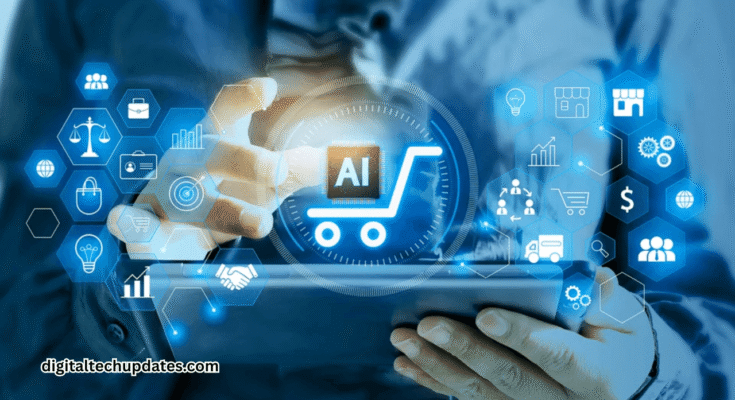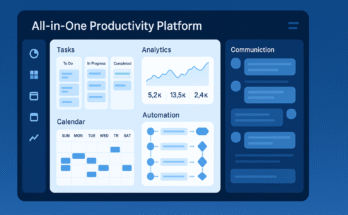Introduction: Why AI is Revolutionizing E-Commerce in 2025
The e-commerce industry is evolving at lightning speed. In 2025, AI-powered tools are no longer optional — they are essential for businesses seeking to compete globally.
From personalizing customer experiences to automating inventory management and predicting trends, AI is enabling online retailers to operate more efficiently and provide smarter shopping experiences.
This article explores the top AI tools transforming e-commerce in 2025, practical applications, and strategies for global business success.
The Role of AI in Modern E-Commerce
AI impacts e-commerce in several key areas:
Customer Experience Personalization: AI analyzes browsing and purchase behavior to recommend products.
Automation: Chatbots, inventory management, and order fulfillment are automated.
Predictive Analytics: Forecast demand and optimize stock.
Marketing Optimization: AI generates ad copy, optimizes campaigns, and segments audiences.
Fraud Prevention: Detects suspicious activity to secure payments and data.
Global e-commerce businesses are increasingly adopting AI to enhance efficiency, reduce costs, and improve conversion rates.
Top AI Tools Transforming E-Commerce in 2025
a. Chatbots and Conversational AI
Tools: Intercom AI, Drift, ManyChat
Function: Handle customer queries 24/7, process orders, and provide recommendations.
Benefit: Reduces customer service costs and increases engagement.
Use Case: Online stores offering multilingual support for international customers.
b. Personalization Engines
Tools: Dynamic Yield, Nosto, Recombee
Function: Personalize website content, emails, and product recommendations.
Benefit: Increases conversion rates by delivering relevant content to each visitor.
Use Case: AI suggests complementary products based on past purchases or browsing history.
c. Inventory & Supply Chain Management AI
Tools: Llamasoft, E2open, ClearMetal
Function: Forecast demand, optimize stock levels, and reduce waste.
Benefit: Ensures timely fulfillment and minimizes overstock.
Use Case: AI predicts peak demand periods during global sales events.
d. Marketing & Advertising AI
Tools: AdCreative.ai, Albert.ai, Pattern89
Function: Automates ad creation, optimizes targeting, and analyzes campaign performance.
Benefit: Improves ROI and reduces manual effort.
Use Case: AI automatically creates personalized ad creatives for global audiences.
e. AI for Visual Search & Product Discovery
Tools: ViSenze, Slyce, Clarifai
Function: Allows customers to search products using images.
Benefit: Enhances user experience and drives conversions.
Use Case: Customer uploads a photo of a product; AI finds exact or similar items.
f. Fraud Detection & Security AI
Tools: Kount, Riskified, Sift
Function: Detects fraudulent transactions and protects customer data.
Benefit: Reduces losses due to fraud and builds customer trust.
Use Case: AI flags suspicious activity during checkout in real time.
Benefits of AI-Powered Tools in E-Commerce
Efficiency: Automates repetitive tasks and streamlines operations.
Enhanced Customer Experience: Personalized interactions increase loyalty.
Data-Driven Decisions: AI provides insights for pricing, marketing, and inventory.
Global Reach: Multilingual support and AI-driven localization.
Cost Reduction: Fewer manual resources needed, more accuracy, and less waste.
How Businesses Can Integrate AI in E-Commerce
Assess Business Needs: Identify which areas — marketing, inventory, or customer service — benefit most from AI.
Select the Right Tools: Choose AI platforms based on features, scalability, and cost.
Integrate with Existing Systems: Ensure compatibility with ERP, CRM, and website platforms.
Train Staff: Employees should understand how to use AI for maximum impact.
Monitor & Optimize: Continuously measure performance and refine AI strategies.
Real-World Examples of AI in E-Commerce
Global Fashion Brand: Uses Dynamic Yield for product recommendations, increasing average order value by 20%.
Online Electronics Retailer: Employs Intercom AI to handle global customer queries, reducing support costs by 40%.
E-Commerce Startup: Uses AI visual search tools to improve product discovery and boost conversions.
These examples show how AI tools are transforming e-commerce globally and giving businesses a competitive advantage.
Future Trends in AI E-Commerce 2025
Voice Commerce: AI voice assistants for seamless shopping experiences.
Hyper-Personalization: AI will use real-time data to tailor experiences per customer.
AI-Powered AR/VR Shopping: Immersive virtual shopping experiences.
Predictive Pricing: AI predicts optimal pricing based on demand, competition, and customer behavior.
Sustainable E-Commerce: AI optimizes supply chains to reduce environmental impact.
FAQs: AI in E-Commerce 2025
Q1: Are AI tools expensive for small businesses?
A: Many AI platforms offer affordable plans suitable for startups and SMBs.
Q2: Can AI replace human employees?
A: AI automates repetitive tasks but enhances human creativity and strategy.
Q3: Which AI tools are best for e-commerce marketing?
A: AdCreative.ai, Albert.ai, Pattern89, Dynamic Yield, and Nosto are top choices.
Q4: How does AI improve customer experience?
A: AI personalizes recommendations, handles queries instantly, and provides faster service.
Q5: Can AI help e-commerce businesses scale globally?
A: Yes, AI supports multilingual content, predictive analytics, and automated operations for international markets.
Conclusion: Embrace AI for Global E-Commerce Success
AI-powered tools are transforming e-commerce in 2025. Businesses adopting AI for personalization, automation, marketing, and analytics are positioned to scale globally, enhance customer experience, and reduce operational costs.
The key is to start early, integrate AI with existing systems, and monitor results to stay competitive in the rapidly evolving digital marketplace.




